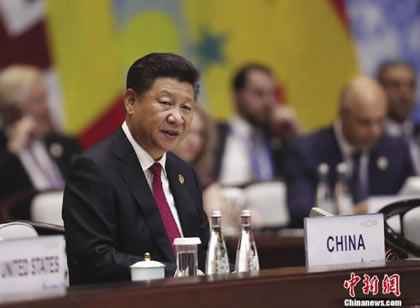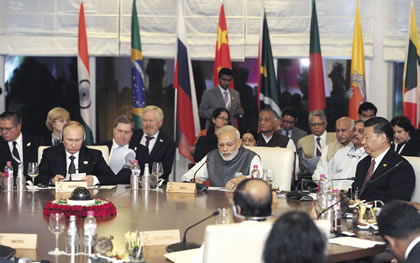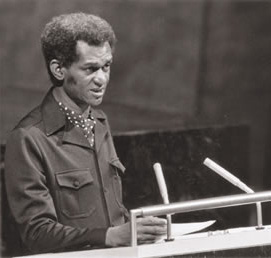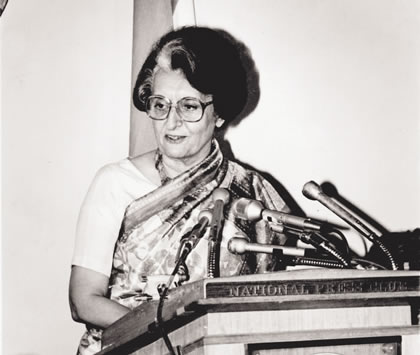The BRICS Summit: A Battlefield Report
by David Christie and Robert Ingraham
November 2016
A PDF version of this article appears in the November 4, 2016 issue of Executive Intelligence Review and is re-published here with permission.

Photo: China News Service
Chinese President Xi Jinping in a G20 address announced a new approach driven by innovation in science and technology to the benefit of all. |

kremlin.ru
Vladimir Putin at the Valdai International Discussion Club, October 27, 2016. |
Oct. 29—The 8th BRICS Summit,[1] which was held on Oct. 15-16 in Goa, India, took place under what can only be described as war-time conditions. The final Summit declaration, issued at the conclusion of the discussions, itself identified the character of the current environment, stating that, “Geopolitical conflicts, terrorism, refugee flows, illicit financial flows and the outcome of the UK referendum have further added to the uncertainty in the global economy.” In his concluding remarks, Chinese President Xi Jinping also pointed to the dangerous problems stemming from the collapse of the trans-Atlantic financial system, describing the present situation as “treacherous.”
In reality, the “treacherous” nature of present world events goes beyond the financial and economic minefield identified by the leadership of the alliance, which consists of Brazil, Russia, India, China, and South Africa. As Russian President Vladimir Putin stated in his October 27 speech to the Valdai Discussion Club,[2] the Obama Administration, together with the elites of London and Wall Street, is now moving openly toward thermonuclear brinkmanship with Russia most specifically, but also with China. This last week alone has seen a dramatic escalation of military support for the terrorists in Syria by the Obama Administration, as well as continued reiterations by Hillary Clinton of her demand for the imposition of a “no-fly” zone in Syria that may well lead to direct U.S.- Russia military conflict.
Thus, it is imperative for the reader to recognize that it is not permissible to discuss the BRICS process as if it existed in an isolated “fishbowl,” nor to examine its proceedings merely from the standpoint of simple global “economic reform.” What is at stake, what is being played out, is the imminent question of the very survival of the nations and people of the world.
China’s Vision
The accomplishments of the Goa Summit were impressive. In almost all respects the discussions and agreements which took place there continued along the positive path earlier identified by both Chinese President Xi Jinping and Russian President Vladimir Putin at the G-20 Summit, held in Hangzhou, China on September 4. At that G-20 Summit, Xi Jinping had issued a clarion call for a new economic order to replace the domination of the collapsing and dying trans-Atlantic financial system, and he announced that a new orientation toward scientific and industrial “innovation” must replace the failed system of the trans-Atlantic conception of monetarism. Xi stated:
We can no longer rely on fiscal and monetary policy alone to deal with the crisis. We envision an all-dimensional, multi-tiered and wide-ranging approach to innovation which is driven by innovation in science and technology, but goes beyond it to cover development philosophy, institutional mechanisms and business models, so that the benefits of innovation will be shared by all.
To get a sense of what Xi Jinping means by innovation, one must look no further than the Chinese space program, and its interrelated commitment to fusion power, which is clearly resonant with the concepts laid out in the “Four Laws”[3] paper by Lyndon LaRouche. From the G-20 Summit in Hangzhou, to the BRICS Summit in Goa, India, this rejection of monetarism and a commitment to innovation has been echoed as a commitment to a new world order based on scientific and technological growth. The final Goa Resolution reads, in part,
We commend China for the successful hosting of the 11th G-20 Leaders’ Summit in Hangzhou and its focus on innovation, structural reform and development as drivers of medium and long term economic growth. We recognize the role of the G-20 as the premier forum for international and financial cooperation and emphasize the importance of the implementation of the outcomes of G-20 Hangzhou Summit, that we believe will foster strong, sustainable, balanced and inclusive growth and will contribute to improved global economic governance and enhance the role of developing countries.
Monetary policy alone, though, cannot lead to balanced and sustainable growth.
From Hangzhou to Goa
Since the G-20 Summit in Hangzhou to the BRICS Summit in Goa, there has been a steady march towards a new global economy based on the principled approach outlined by Xi Jinping in Hangzhou. Earlier this year at the G7 Summit in Japan, Shinzo Abe had already expressed this similar sentiment when he said that monetary policy alone cannot lead to a strong, sustainable, and balanced growth. Abe had also warned of “a risk of the global economy falling into crisis if appropriate policy responses are not made,” which was referred to as a “Lehman shock,” recalling the collapse of 2008. Days before the G-20 Hangzhou Summit, Abe attended the Eastern Economic Forum, where he and Putin made further commitments to the joint development of the Far East, especially Siberia, indicating that Japan may shift to the collaborative approach in Eurasia around the Silk Road and related projects, rather than be caught in the middle of British geopolitical manipulations that could lead to nuclear war. Following the G-20 Summit, the ASEAN nations met, and in the context of the release of The Hague ruling on the South China Sea dispute between China and the Philippines, made a commitment to resolve their issues without outside manipulation, through mutual development around the Silk Road. Philippine President Duterte’s recent remarks indicate a clear and resolute shift on the part of the Philippines, also seen in his recent trip to Japan.
In addition to the tectonic changes in policy orientation emanating from both the Philippines and Japan, Turkey has also shifted towards the orientation of the New Silk Road. At the G-20 Summit in Hangzhou, Turkish President Erdogan described the New Silk Road as starting in China and ending in the United Kingdom, referring to Turkey’s megaprojects, such as the subsea tunnel project and the Yavuz Sultan Selim Bridge, Istanbul’s third bridge over the Bosporus, as indicators of future megaprojects which include new railway systems and various other megaprojects in line with China’s Silk Road policy. Turkey is also working with Russia and Azerbaijan on the North South Corridor, which will bring together Russia, Azerbaijan, Turkey and Iran, and will ultimately fold into China’s One Belt, One Road initiative.
Perhaps the most striking feature of the G-20 Summit in Hangzhou was the declaration by Xi Jinping that the success of China is a model for the world. Prior to the G-20 Summit, China had issued a call for the Bank for International Settlements (BIS) to evaluate the status of global financial derivatives, which of course were shown to be in abysmal shape, a contagion spreading among the international banks. In this context, Xi Jinping issued an international proposal for a new financial architecture, to facilitate the innovation economy, most clearly seen with China’s commitment to the New Silk Road, fusion research, and its space program. President Xi also very clearly asserted that the method by which China has pulled 800 million of its people out of poverty is both knowable and replicable.
None of this has gone unnoticed in London and Washington, and in an article which appeared in Consortium News, the British specialist Alastair Crooke astutely noted,
What was different was that it was distinctly China’s G-20. China did not simply host the G-20 for America to sweep in, give its leadership and stamp to proceedings, and then to fly off. China, at this G-20, made it very plain that it was leading, and to make it clearer still, it made sure that the world should see that the guest of honor was the Russian president, and not the American president (who regrettably experienced some technical difficulties that marred his ceremonial arrival). There was a deeper purpose here: to underline strategic coordination with Russia in the context of the display of the Chinese leadership.[4]
Vladimir Putin also asserted this shift in his press conference after the G-20, stating that while the “G-20 does not make legally binding decisions, the value of such discussions and such documents lies elsewhere. Their value is that they set a trend.” Putin continued, noting that “the Chinese presidency has chosen ensuring sustainable long-term growth through innovation as the key topic,” and that if other nations move in a different direction than the “trend,” then they act “contrary to the wish of the global community and violate, as it were, generally accepted norms, even if they are not obligatory. These trends are very important. So there is a certain value in this and it is quite significant.”
These statements illustrate that it is now Russia and China who are setting the trend, which does not sit well with either Obama or his British masters.
At Goa
In his statements from the BRICS Summit in Goa, Xi Jinping identified the severe problems stemming from the global instability of the trans-Atlantic financial system, but he also declared that the BRICS nations would collaborate on a basis of mutual benefit, around projects designed to create tangible economic development. He noted that the global economy is in the midst of a “treacherous recovery,” while adding that despite these difficulties, “the potential and strength of the BRICS countries in terms of resources, market and labor force is unchanged,” and that the BRICS continues to pursue a positive future. Xi Jinping then affirmed that the BRICS countries indeed have much of which to be proud: “The past decade has seen BRICS partnerships expanding with win-win results. We need to deepen our partnerships. We BRICS countries are good friends, brothers and partners that treat each other with sincerity.”
Indian Prime Minister Narendra Modi seconded that sentiment, addressing the BRICS Business Council, saying, “I think I speak for all when I say that through a common vision and collective action, we will create and sustain deeper bonds among BRICS nations, develop our economies and secure our societies. While our achievements have been substantial, we need to sustain the positive direction and strong momentum of intra-BRICS engagement.”
View full size
PIB, India
Russian President Putin, Indian Prime Minister Modi, and Chinese President Xi with BIMSTEC leaders at the BRICS Summit in Goa, India. |
At the same Business Council meeting, Russian President Vladimir Putin, emphasizing the importance of establishing contacts and cooperation between the Business Council and the NDB,[5] said, “We hope to see relevant recommendations from the business community on expanding project activity with the Bank.” Putin noted that the first BRICS Trade Fair held in New Delhi Oct. 12-14 with Business Council support, showed “our countries’ real potential for developing economic cooperation and expanding our work together in industry and technology.” Russia will continue efforts to facilitate economic rapprochement among BRICS countries and to lay the groundwork for launching new business projects, he said.
In addition to the positive assertion of economic development uniting nations in mutual benefit through the New Development Bank, the BRICS nations also discussed an expanded role in dealing with issues of the global strategic situation. In addition to expanding the outreach of the BRICS by inviting the leaders of the BIMSTEC[6] member countries (comprising Bangladesh, Bhutan, India, Myanmar, Nepal, Sri Lanka and Thailand), the BRICS also made clear their intent to intervene into the situation in the Middle East and Northern Africa, particularly the situation in Syria, as the Goa declaration states:
We are deeply concerned about the situation in the Middle East and North Africa. We support all efforts for finding ways to the settlement of the crises in accordance with international law and in conformity with the principles of independence, territorial integrity and sovereignty of the countries of the region. On Syria, we call upon all parties involved to work for a comprehensive and peaceful resolution of the conflict taking into account the legitimate aspirations of the people of Syria, through inclusive national dialogue and a Syrian-led political process based on Geneva Communique of 30 June 2012 and in pursuance of the UN Security Council Resolution 2254 and 2268 for their full implementation, while continuing the relentless pursuit against terrorist groups so designated by the UN Security Council including ISIL, Jabhat al-Nusra and other terrorist organizations designated by the UN Security Council.
It has not been lost on Barack Obama and his British masters that their influence is waning—in the Middle East, Northern Africa and elsewhere, nor that it is now Vladimir Putin who is playing such a decisive role in the former geopolitical sandbox of the British Empire. Reportedly, Putin has now also been invited to play a role in the Israeli Palestinian peace process. Meanwhile, BRICS nations India and China have also been very active in the region; note particularly the role of China in reaching agreements with Middle Eastern nations, even including the Kingdom of Saudi Arabia, for economic development projects integrated into the New Silk Road.
Casus Belli for London
It is important to understand that the BRICS is not simply a collection of nations. Representing a “Community of Principle,” its potential goes far beyond the realm of Realpolitik. Lyndon LaRouche has outlined the essence of that principle in his paper entitled “The Four Laws to Save the U.S.A. Now! Not an Option: An Immediate Necessity,”[7] and he has identified that his Four Laws are essentially a distillation of the four seminal works of Alexander Hamilton that were delivered to the United States Congress: on Public Credit, the Subject of Manufactures, the National Bank, and the Constitutionality of the National Bank. In those four works, Hamilton organized the nation to establish itself on the principles of natural law and renounce the bestiality of the British imperial system that had slavery at its core—whether it was chattel slavery that imposed literal shackles, or the British imperial system of “free trade” and monetarism that condemned colonies and foreign nations to backwardness and servitude.

EIRNS
Guyanese Foreign Minister Fred Wills, a friend of Lyndon and Helga LaRouche, called for new international development banks at the UN in 1976. |
While the expanding role of the BRICS in international affairs is important, their action in asserting the primacy of innovation over the failed monetarist outlook of the trans-Atlantic system is even more important. The BRICS Declaration also refers to the importance of “structural reforms,” which, for the BRICS, takes on a far different meaning than it does in the Orwellian language of the International Monetary Fund or other agencies of the British Empire. Wall Street and London-dictated “structural reforms” almost always demand privatization, deregulation, and breaking down trade barriers or protectionist measures, so that the population and governments can be looted—whereas in the BRICS Goa declaration, they refer to “industrial development as a core pillar of structural transformation.” That declaration states:
Monetary policy alone, though, cannot lead to balanced and sustainable growth. We, in this regard, underscore the essential role of structural reforms. We emphasize that our fiscal policies are equally important to support our common growth objectives. We also take note that the spillover effects of certain policy measures in some systemically important advanced economies can have adverse impact on growth prospects of emerging economies.
We recognize that innovation is a key driver for mid- and long-term growth and sustainable development. We stress the importance of industrialization and measures that promote industrial development as a core pillar of structural transformation.
The Empire’s Counterattack
The British Empire has specifically targeted the scientific and technological foundation of the innovation based economy, as well as the industrial growth and growth of infrastructure. It has unleashed hysterical psychological warfare operations against these concepts, lying that this type of growth is not sustainable or even desirable. This is clearly evident in two recent pieces by the propaganda outlets of the British Empire: “China rethinks developing world largesse as deals sour—An end to risky bets on the ‘red elephants’ of Beijing’s global financial diplomacy?” from the Financial Times, and “Does Infrastructure Investment Lead to Economic Growth or Economic Fragility? Evidence from China,” from the Oxford Review of Economic Policy.

EIRNS/Stuart Lewis
Indira Gandhi, another friend of the LaRouches, was killed by the British in 1984. |
According to the Financial Times article, China’s huge investments around the world, “in some of the most unstable countries in Latin America, Africa and Asia,” are now turning sour, and its “sources” in China assure them that Beijing is now ready to dump the whole project! Yet, in the course of their screed, the Financial Times writers are forced to admit that the China Development Bank and the Ex-Im Bank of China together have about $700 billion in overseas development lending, which is fairly equivalent to the development lending of the World Bank, the Asian Development Bank, the Inter-American Development Bank, European Investment Bank, the European Bank for Reconstruction and Development, and the African Development Bank—combined! China is also clearly taking a leading role in the Asian Infrastructure Investment Bank (AIIB) and the BRICS’ New Development Bank (NDB).
Similarly in the Oxford Review of Economic Policy piece, one of the authors, Dr. Atif Ansar, argues that, “From our sample, the evidence suggests that for over half of the infrastructure investments in China made in the last three decades, the costs are larger than the benefits they generate, which means the projects destroy economic value instead of generating it. . . Unless China shifts to fewer and higher-quality infrastructure investments, the country is headed for an infrastructure-led national financial and economic crisis, which is likely to spread to the international economy.”
The intended target of this article is not hidden: the Oxford University review study concludes, “that a massive infrastructure investment program is not a viable development strategy for other developing countries such as Pakistan, Nigeria or Brazil, which may use China as their model for economic development.” Quoting from the report: “It is a myth that China grew thanks largely to heavy infrastructure investment. It grew due to bold economic liberalization and institutional reforms, and this growth is now threatened by over-investment in low-grade infrastructure. The lesson for other markets is that policy makers should place their attention on software and deep institutional reforms, and exercise far greater caution in diverting scarce resources to large-scale physical infrastructure projects.”
A splash of cold water is enough to recognize that the assertions made in these articles are nothing other than the desperate flailings of hysterical losers who are now about to lose everything when the insolvent trans-Atlantic banking system comes crashing down, an imminent certainty which might be sparked by almost anything, from the likely fall of Deutsche Bank, to the implosion of the Italian banking system, or the collapse of almost any bank in Wall Street or London for that matter.
Two Opposite Outlooks
The truth of these matters was actually revealed in the Financial Times article, in a section which quoted from a top unnamed Chinese official. According to the article, when the official was asked about the “rate of return” on Chinese investments, he stated,
We assess risk differently than western agencies because we look at the potential for development of a country. They look backwards, we look forwards. We know that maybe all they need is infrastructure and . . . their economy will grow.
This short statement has extraordinary implications, but the simple truth expressed therein seems lost on the mavens of London and Wall Street. If your nation is considering creating a future potential through the growth associated with basic economic infrastructure, in collaboration with other nations, then long term investment is not seen as “risk.” This disparate view of “risk” has led the BRICS to discuss setting up their own rating agency. The BRICS Goa declaration said,
We welcome experts exploring the possibility of setting up an independent BRICS Rating Agency based on market-oriented principles, in order to further strengthen the global governance architecture.
We believe that BRICS institution-building is critical to our shared vision of transforming the global financial architecture to one based on the principles of fairness and equity.
Prime Minister Narendra Modi also said in a statement at the conclusion of the BRICS Summit that, “In order to further bridge the gap in the global financial architecture, we agreed to fast track the setting up of a BRICS Rating Agency.”
Although unnamed in the above, or in any of the other documents from the Goa summit, what is actually being discussed here is Alexander Hamilton’s concept of Public Credit, precisely the approach which created the American Republic, and the solution put forward by Lyndon LaRouche to the current crisis.
View full size
U.S, National Archives
Depiction of a brief skirmish at Lexington, Massachusetts, April 19, 1775. |
The British Empire knows that what Xi Jinping stated with clarity and force at the G20 Summit in Hangzhou sounds its death knell. In order to crush this concept from becoming hegemonic in the BRICS nations and beyond, it is trying to both destroy the nations involved and pit them against each other, as well as destroy the idea that is uniting them, with psychological warfare techniques. The BRICS nations have all been specifically challenged with hybrid warfare in all its forms—from an attempted impeachment in South Africa, to a coup d’etat through impeachment in Brazil, to Russia bearing the brunt of the war assault in both Syria and Ukraine, to the threatening of China from Obama’s Asia Pivot. The British have even torn open scar tissue in Kashmir in an attempt to pit India against China. In addition to the assault on the nations of the BRICS, the British have also launched a massive psychological warfare campaign to convince the world of the impenetrability of the trans-Atlantic system—and that rather, it is China and the BRICS that are crumbling due to their overextension on infrastructure and foreign investments.
This is a global war. It is a war which superficially appears to be between two systems, but in reality is between two diametrically opposed Principles, two antagonistic concepts of humanity’s future. The conceptual grasp of that new Principle offered by the BRICS process—a Principle fully coherent with the Hamiltonian origins of the American Republic—by a growing chorus of leaders, will be the foundation for destroying the British Empire forever. We are now at the edge of that conceptual shift, if we have the courage to provide the intellectual and moral leadership to bring down the British Empire and create that New Paradigm.
Footnotes
[1]. Brazil-Russia-India-China-South Africa
[3]. "The Four New Laws To Save the U.S.A. Now! Not an Option: An Immediate Necessity," Executive Intelligence Review, June 13, 2014.
[4]. “China and Russia Press Ahead, Together,” Consortium News, Sept. 13, 2016.
[5]. The New Development Bank of the BRICS.
[6]. The Bay of Bengal Initiative for Multi-Sectoral Technical and Economic Cooperation.
[7]. "The Four New Laws To Save the U.S.A. Now! Not an Option: An Immediate Necessity," Executive Intelligence Review, June 13, 2014.

